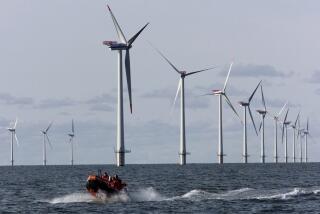No Threat to Condors in Gorman Area : Windmills Found Environmentally Safe
- Share via
The location of a proposed wind farm in Gorman is outside traditional flight patterns of the endangered California condor, and its power-generating windmills would not threaten the giant birds if scientists reintroduce them to the region, according to an environmental impact report.
The report, released Monday, also said the 350-turbine wind farm, the first such enterprise proposed for Los Angeles County, would not erode soil or otherwise harm the environment. Environmentalists said they had not yet read the report, but argued Tuesday that the towering windmills would prove fatal to birds, including the condor, and destroy the region’s rustic character.
The report was prepared by Sierra Delta, a Las Vegas consulting firm, for the Tehachapi-based Zond Systems, the largest producer of wind energy in California. The report will be reviewed by the Los Angeles County Regional Planning Commission when it considers Zond’s request for a conditional-use permit to erect the windmills, some of them 150 feet tall, east of Gorman.
Zond originally proposed building 458 windmills but scaled back the proposal. The project will cost about $80 million, said George Stricker, a Zond consultant.
Outside ‘Flyways’
Stricker said the report found that the windmills would be outside traditional routes or “flyways” favored by California condors. But the National Audubon Society has said the farm would block a historic and once well-traveled condor route, said Allene Zanger, a member of the Save the Mountain Committee, a citizens group opposing the project.
Zanger had not yet read the report but said the committee would review it skeptically. Zanger also is a spokeswoman for the giant 20,000-acre Tejon Ranch, which opposes the Zond project.
The 31 California condors known to exist are kept at the San Diego and Los Angeles zoos. Three chicks have been born since April, the most recent on Sunday. A fourth egg is expected to hatch in June. If the captive breeding program proceeds successfully, scientists hope to reintroduce some of the birds to their natural habitat in the 1990s.
The report suggested that the birds could be protected by outfitting them with electrical warning devices which would alert wind farm operators that they were nearby. The turbines could then be turned off to protect the birds, the report said.
Stricker said scientists probably will attach homing devices to the birds anyway to monitor their whereabouts.
Gorman residents have charged that the wind farm will destroy fields of the area’s distinctive wildflowers. Stricker said Zond is planning to create a wildflower preserve next to the wind farm.
More to Read
Sign up for Essential California
The most important California stories and recommendations in your inbox every morning.
You may occasionally receive promotional content from the Los Angeles Times.













